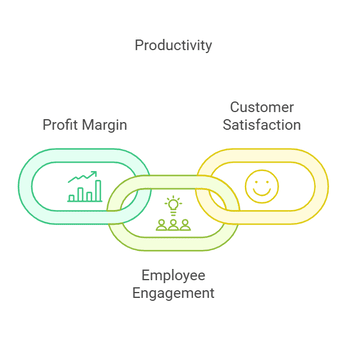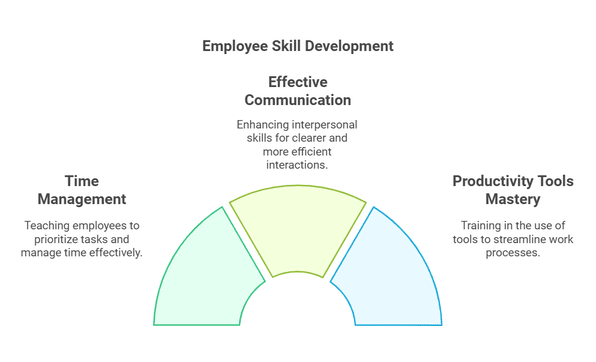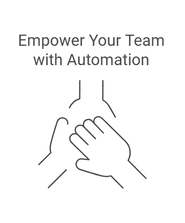How to Increase Productivity in a Business

Important Takeaways
-
Set clear goals, organize tasks, and use tools to make work easier.
-
Reward hard work, keep meetings short, and create a happy workspace.
-
Manage time better, let your team take charge, and try tools like Apploye to track progress.
Think about your dream business day. The team is focused, tasks are completed on schedule, and customers care about your efficiency. Sounds great, right?
Now, think about how often that happens. If it feels like a rare event, you’re not alone. All of the business owners and managers chase to improve business productivity.
However, increasing productivity doesn’t require a magic wand. It needs to take the right approach.
In this post, we’ll explore practical ways to make your business more productive and efficient, which include:
- Organizational Strategies
- Technology and Tools
- Time Management
- Personal Productivity
- Work Habits
- Well-being and Motivation
Let’s get started!
Why Productivity is a Critical Success Factor?
The answer lies in different productivity metrics in business. They rate how you utilize your time, resources, and workforce to drive the desired output. They also provide various business analytics for efficiency.
Productivity sets important key performance indicators (KPIs). Let’s explore why productivity is a game-changer and how it can transform your business.
Enhancing Workplace Efficiency
When tasks are well-organized, priorities are clear, and resources are put to their best use, your team can do more in less time. You better understand what is going on and what you need to do.
According to Gallup, the company with highly engaged employees experiences 23% higher profitability.
Streamlining Business Operations
The productivity-oriented measures will ensure smooth workflows, quicker turnarounds, and improved overall performance.
Productivity software solutions can integrate many tools that automate and speed up processes. This allows your business to handle a heavy workload with ease.
Reducing Workplace Stress
Productivity reduces stress in the workplace. Everything is easier when you have clear goals, efficient workflows, and the right tools to do the job.
Plus, when teams collaborate well and tasks are well delegated, no one feels like they're carrying the whole load. Work becomes much more fulfilling with fewer bottlenecks, less scrambling to meet deadlines, and more control over your schedule.
Drives Profitability

Productivity drives profitability, and it ensures your business makes more from less. Smooth and effective operations reduce waste, cut costs, and maximize the value of every hour worked. They raise workplace productivity. You can get a higher profit margin, employee engagement, and customer satisfaction.
Enhances Customer and Employee Satisfaction
A productive environment enables better communication among employees and customers.
When companies pay attention to how organized their operations are and the workflows run smoothly for their internal teams and the people they serve, it is a win-win condition.
Provides Measurable Success Through KPIs
KPIs will provide you with an indication of your productivity levels and their subsequent impact on success. It is essential to have KPIs in place to align productivity goals with overall business objectives.
Want to increase company productivity? Check out Apploye.
What can a Business do to Improve its Productivity?
Productivity improvement is a collective process in which employers and employees must be consistent to grow. They have to adopt many business productivity strategies.
A company with a high level of productivity is compatible and sustainable. It can produce high-quality goods and retain customer satisfaction. Here are the strategies a company and its people can apply to improve productivity.
Here are the steps a company can take to enhance their output:
Organizational Strategies
1. Establish Clear and Measurable Goals
Set clear, achievable goals that everyone can rally behind. Make sure these goals are measurable. You can track progress and celebrate milestones along the way.
Whether completing projects on time, increasing sales, or getting better customer feedback, measurable goals keep you focused. It's just a simple way of keeping everyone moving forward together.
2. Communicate Goals and Objectives
Everybody on your team should know what they are working on and why it matters. Clear communication builds alignment so that there is no confusion about priorities. Every individual can play his role properly and make sure that his work is aligned with the business needs.
3. Incorporate Productivity Training into Employee Development Programs
Visualize setting up your employees with such skills as time management, effective communication, or mastering new productivity tools. These are not just workplace hacks. They are life skills that make their jobs easier and more rewarding.
Workshops, online courses, or hands-on training sessions help empower your team to handle tasks more straightforwardly and save a lot of stress.
4. Regularly Review the Current Processes
Take a step back and assess how your business works. Are there some things that take more time than they should? Note what gets in the way and think about ways to streamline it. A little fine-tuning goes a long way toward speeding things up.
5. Build a Positive Working Environment

A positive working environment is the foundation of a happy, motivated, and productive team. If employees feel valued, supported, and genuinely appreciated, it builds an atmosphere where they would want to give their best.
Building this kind of culture doesn't take grand gestures. Sometimes, the smallest things make the biggest difference.
6. Introduce Standing Meetings for Quick Updates
Standing meetings are a simple, powerful way to align your team without wasting too much time. Instead of long discussions around a conference table, everybody assembles for a quick, focused check-in while standing.
The format naturally keeps things concise and on-topic. They create a rhythm for your team, helping everyone stay connected and clear on priorities.
7. Reward the Well-Performing Employees
One of the easiest ways to keep morale and motivation strong is by recognizing and rewarding well-performing employees. A little recognition can mean great when one puts their heart into something. It doesn't have to be anything over the top.
A genuine 'Thank you' from the bottom of your heart in front of a team, a handwritten note, or anything small like a gift card or an extra day off goes a long way. These show that you see their effort and truly appreciate them.
8. Empower the Employees to Own the Task
Giving your employees ownership of their work makes them flexible enough to take charge without hesitation. Empowered employees feel responsible and proud of their work because they know their contributions count. They become more engaged, better motivated, and go that extra mile.
By stepping back and letting them take charge, you're building a culture of accountability and growth where everyone feels valued and inspired to do their best.
What people can achieve is impressive when they know you believe in them.
9. Do Not Micromanage Teams
Nobody performs better if he is watched every second. Give your team some space and freedom to work independently without keeping them under continuous observation.
Intervene only when you think it's high time when they require your help or advice. This gives them a sense of being trusted in their capability.
10. Create a Distraction-Free Workspace
Let your environment support your work. Quiet space, ergonomic furniture, and proper equipment can do wonders.
Healthy employees, productive employees. Offer programs like fitness classes, counseling, or stress management workshops.
11. Facilitate Remote Employee Engagement
It's about facilitating remote work by giving you the freedom and the tools to do your best wherever you feel most comfortable and focused. Just imagine no more exhausting commutes, no office distractions, and the flexibility to structure your day around what works for you.
Technology and Tools

12. Automate Repetitive Tasks
Automation saves employee hours and errors. Think of this as giving your team extra hands. Work gets done in minimum time with increased accuracy, and stress levels go down.
When any team is not burdened with repetitive work, it can concentrate on being creative, solving problems, and driving the business ahead. Automation is not just about saving time. It changes the whole dynamic of productivity and morale.
13. Implement Smart tools for Productivity
Productivity apps are game-changers for businesses and individuals alike. Productivity apps let everyone share updates, keep track of progress, and stay on the same page no matter where your team might be.
They are not just tools but a secret weapon to staying focused, productive, and stress-free.
14. Use Analytics for Measuring Productivity Metrics
Run performance data regularly, and you'll get a pretty accurate view of what flies and what might need a little extra. It's like having that roadmap to your next steps.
Analysis tools make the process of breaking down the numbers, identifying trends, and showing areas of improvement. It gives you insight into making informed decisions that move the needle.
15. Artificial Intelligence in Business
Artificial Intelligence is rapidly revolutionizing businesses. By equipping them with tools to automate processes and analyze data, AI can help companies be more efficient, cut costs, and offer their customers better products and services.
16. Machine Learning for Efficiency
Machine Learning, as a subset of AI, is an area that deals with enabling systems to learn and improve from data without explicit programming. It helps you automate complex processes and improve operational efficiency.
Here are the steps individuals can take to boost productivity:
Time Management
17. Prioritize Tasks
Begin your day by making a to-do list. Split all the tasks based on urgency and importance using tools like the Eisenhower Matrix. Doing high-impact tasks puts your energy and focus into work, which matters most when your mind is sharpest.
18. Avoid Multitasking
Focus on completing one task at a time. While multitasking may feel efficient, research shows it reduces productivity and increases the likelihood of mistakes.
19. Use Time-Blocking or the Pomodoro Technique
Block out your day in work sections, specific times for tasks, meetings, and even breaks. For deep work, use the Pomodoro technique. Work in 25-minute intervals with a 5-minute break after each session. Take a more extended break after completing four Pomodoros.
20. Keep Time-Wasting to a Minimum
Identify distractions like social media, excessive meetings, or idle browsing. Use browser blockers or set dedicated times to check emails and messages.
Minimizing interruptions allows for longer stretches of deep focus and increases the quality of your work.
Personal Productivity
21. Take Regular Breaks
Schedule short breaks throughout your day. Step away from your desk, walk, or do light stretching. These activities recharge your mind and body.
It allows you to sustain productivity over long periods.
22. Limit Distractions
Minimizing distractions can create an environment for your brain to work best. Set boundaries to create a distraction-free workspace. Switch off unnecessary notifications on your devices. Communicate with colleagues when you need focused time.
23. Exercise Regularly
Exercise increases endorphins and helps with mental clarity. Regular exercise boosts energy, concentration, and overall health, making you more productive during the day.
For example, aerobic exercise can be as little as a 10-minute walk or a short yoga routine.
Work Habits
24. Delegate Effectively
Focus on what you do best and delegate tasks outside your expertise or priority. Communicate clearly when delegating to ensure the task is executed correctly.
25. Develop New Skills
Take the lead in developing skills to improve efficiency or expand capacity. It will allow you to tackle tasks more effectively and efficiently.
Well-being and Motivation
26. Build a Routine that Balances Work and Personal Life
Draw a schedule that accommodates your work, personal activities, and rest. A routine will help you smoothly transition from your professional to your personal life. Balance keeps you productive without feeling overwhelmed.
27. Maintain a Positive Mindset
Approach challenges with curiosity and a problem-solving attitude. Setbacks are opportunities to learn and grow, not failures. A positive attitude keeps you motivated and able to navigate obstacles more easily.
28. Work with Others
Working with others can spark fresh ideas, workload sharing, and creativity. Be open to brainstorming and cooperation. Working together allows everyone to be creative while making the workplace fun and productive.
29. Establish Personal Goals and Monitor
Clearly defined, realistic personal goals and regular review of your progress will allow you to celebrate milestones and motivate yourself. Goal setting and tracking provide direction and purpose.
Conclusion
Whether a business leader implements smooth processes or an individual tunes daily habits, each step counts toward being more efficient and successful.
So, initiate with the smallest and remain consistent. Watch the wonders bring into your workplace and personal life with such changes.
Here's to smarter working, achieving more, and enjoying it!

